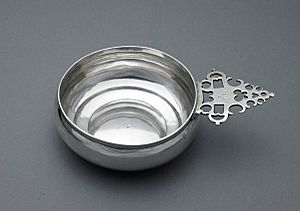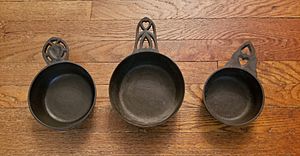Porringer facts for kids
A porringer is a special type of shallow bowl. It's usually about 4 to 6 inches (10 to 15 cm) wide and 1.5 to 3 inches (4 to 8 cm) deep. Porringers first appeared in Europe during the Middle Ages. They were made from many different materials, like wood, ceramic, pewter, cast iron, and silver. Most porringers have flat handles on the side.
People aren't completely sure what porringers were mainly used for. However, many believe they were perfect for holding warm foods like broth or a thick soup called gruel. In France, these bowls were known as écuelles.

Contents
History of Porringers
Porringers made in the American colonies often had just one handle. But European porringers usually had two handles, one on each side. Sometimes, the owner's initials were carved into these handles. Some porringers even came with a lid to keep the food warm. Porringers looked a bit like a smaller Scottish drinking cup called a quaich.
How to Identify Old Porringers
You can often tell if an old pewter porringer is real by looking for special marks. These "touch marks" were like stamps that makers put on their items. They could be found inside the bowl or on its bottom. These marks help prove who made the porringer and when.
Wooden porringers are harder to find, but archaeologists sometimes discover them during digs. For example, a 16th-century wooden porringer was found in Southwark, England, and an 11th-century one in Winchester.
One of the most famous makers of porringers in colonial America was Paul Revere. He was well-known for his silver items.
Porringers Today
In more recent times, some companies have made porringers without handles. These look more like deep, simple bowls. Porringers are not as common today because regular bowls work just fine for most people. However, they are still sometimes given as special gifts, especially for christenings (baby naming ceremonies).
Porringers for Cooking
The word "porringer" can also mean a special type of double saucepan. This kind of porringer is similar to a bain-marie, which is used for gentle cooking. It's often used to cook porridge.
Here's how it works:
- The porridge cooks slowly in the inner pot.
- This inner pot is heated by steam from boiling water in the outer pot.
- This method stops the porridge from burning.
- It also allows the oats to cook longer and soak up more water or milk.
- You don't need to stir the porridge much, so the oats stay whole. This gives the porridge a better texture.
- Cooking at a lower heat might also help keep more of the healthy beta-glucan in the oats. Beta-glucan is what helps lower cholesterol.
Other Materials and Names
Porringers were also made from earthenware clay. This clay turns red when fired, so it's called "redware" today. In colonial times, it was just called "earthen" pottery. These clay porringers often had a handle like those on modern mugs.
Some collectors or historians might also call a pewter porringer a "bleeding cup."
See also
 In Spanish: Escudilla para niños
In Spanish: Escudilla para niños


